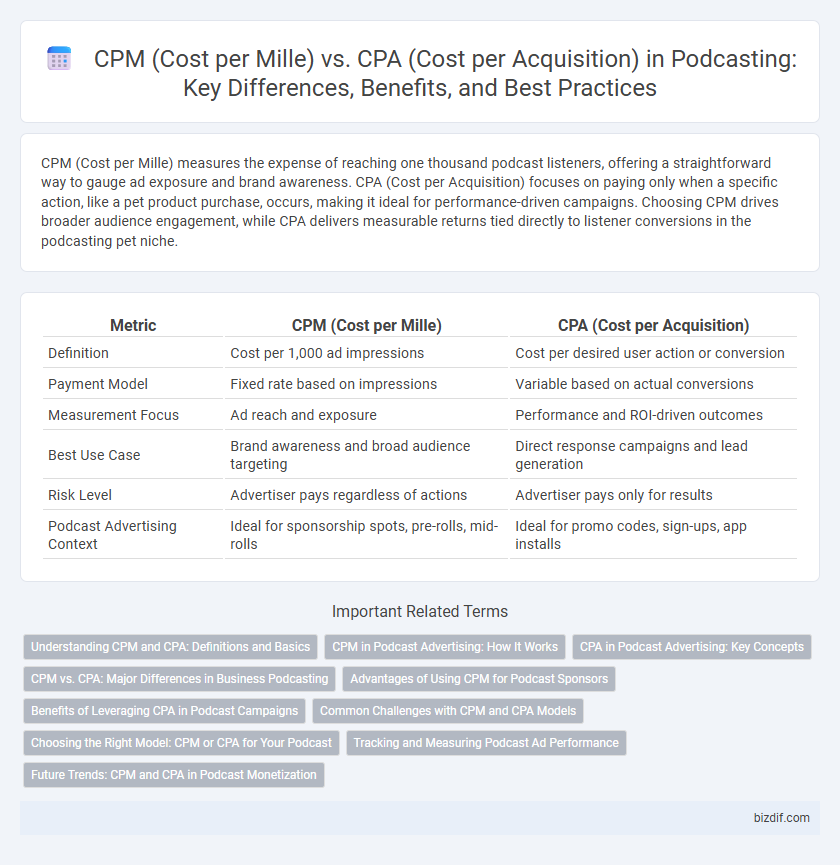CPM (Cost per Mille) measures the expense of reaching one thousand podcast listeners, offering a straightforward way to gauge ad exposure and brand awareness. CPA (Cost per Acquisition) focuses on paying only when a specific action, like a pet product purchase, occurs, making it ideal for performance-driven campaigns. Choosing CPM drives broader audience engagement, while CPA delivers measurable returns tied directly to listener conversions in the podcasting pet niche.
Table of Comparison
| Metric | CPM (Cost per Mille) | CPA (Cost per Acquisition) |
|---|---|---|
| Definition | Cost per 1,000 ad impressions | Cost per desired user action or conversion |
| Payment Model | Fixed rate based on impressions | Variable based on actual conversions |
| Measurement Focus | Ad reach and exposure | Performance and ROI-driven outcomes |
| Best Use Case | Brand awareness and broad audience targeting | Direct response campaigns and lead generation |
| Risk Level | Advertiser pays regardless of actions | Advertiser pays only for results |
| Podcast Advertising Context | Ideal for sponsorship spots, pre-rolls, mid-rolls | Ideal for promo codes, sign-ups, app installs |
Understanding CPM and CPA: Definitions and Basics
CPM (Cost per Mille) refers to the cost an advertiser pays for one thousand impressions of a podcast ad, emphasizing brand exposure and reach. CPA (Cost per Acquisition) measures the cost associated with acquiring a specific customer or action, focusing on direct conversions and return on investment. Understanding these metrics enables podcasters and advertisers to choose strategies aligned with campaign goals, whether maximizing audience impressions or driving measurable user actions.
CPM in Podcast Advertising: How It Works
CPM (Cost per Mille) in podcast advertising charges advertisers based on every thousand ad impressions, providing predictable budgeting and wide audience reach. Advertisers pay for the number of times their ad is heard, regardless of listener actions, making CPM ideal for brand awareness campaigns. Podcast CPM rates vary widely, influenced by factors such as audience size, niche, and ad placement within episodes.
CPA in Podcast Advertising: Key Concepts
CPA (Cost per Acquisition) in podcast advertising measures the cost incurred for each listener action, such as a purchase or sign-up, providing a direct link to campaign effectiveness. Unlike CPM (Cost per Mille), which charges per thousand impressions and focuses on audience reach, CPA emphasizes measurable return on investment by tracking specific conversions. Advertisers prefer CPA for its performance-based model, ensuring budgets are spent only when desired listener engagements occur, making it ideal for targeted marketing strategies in podcast campaigns.
CPM vs. CPA: Major Differences in Business Podcasting
CPM (Cost per Mille) measures advertising cost per thousand impressions, focusing on brand awareness in business podcasting, while CPA (Cost per Acquisition) tracks costs based on specific listener actions, such as lead generation or sales conversions. CPM campaigns optimize reach and frequency to build a broad audience, whereas CPA targets measurable outcomes and return on investment through direct response ads. Choosing between CPM and CPA depends on whether the goal is maximizing exposure or driving concrete business results within the podcasting environment.
Advantages of Using CPM for Podcast Sponsors
CPM (Cost per Mille) offers podcast sponsors predictable budgeting by charging a fixed rate for every thousand ad impressions, ensuring broad audience exposure and brand awareness. This model facilitates easy measurement of reach and frequency, making it ideal for campaigns focused on maximizing listener engagement rather than immediate conversions. Sponsors benefit from consistent ad placement within popular podcasts, leveraging the medium's loyal and targeted audience to build long-term brand recognition.
Benefits of Leveraging CPA in Podcast Campaigns
CPA in podcast campaigns ensures advertisers pay solely for actual conversions, maximizing budget efficiency and ROI. Unlike CPM, which charges per thousand impressions regardless of listener action, CPA aligns costs directly with measurable results such as product purchases or sign-ups. Leveraging CPA reduces wasted ad spend and enables precise performance tracking, making it ideal for brands targeting tangible business outcomes through podcast advertising.
Common Challenges with CPM and CPA Models
CPM (Cost per Mille) models in podcasting often face challenges such as inaccurate audience measurement and limited ability to track listener engagement, leading to less precise ad targeting. CPA (Cost per Acquisition) models can struggle with attribution issues, as tracking conversions directly linked to podcast ads is complex, especially when listener actions occur offline or through multiple touchpoints. Both models require robust analytics and transparent reporting to optimize ad spend and demonstrate real ROI for podcast advertisers.
Choosing the Right Model: CPM or CPA for Your Podcast
Selecting the right pricing model for your podcast advertising depends on your campaign goals and audience engagement levels. CPM (Cost per Mille) offers predictable costs based on impressions, ideal for brand awareness and maximizing reach across targeted listener demographics. CPA (Cost per Acquisition) focuses on performance by tying costs to specific actions like subscriptions or sales, making it suitable for advertisers prioritizing measurable conversions and ROI.
Tracking and Measuring Podcast Ad Performance
CPM (Cost per Mille) measures podcast ad costs based on every thousand listens, providing straightforward tracking through download and impression metrics. CPA (Cost per Acquisition) focuses on actions like purchases or sign-ups, requiring detailed attribution methods such as unique promo codes or dedicated landing pages for precise conversion tracking. Selecting between CPM and CPA depends on campaign goals and the ability to measure listener engagement and conversion accurately within podcast platforms.
Future Trends: CPM and CPA in Podcast Monetization
Future trends in podcast monetization highlight a shift towards hybrid models combining CPM (Cost per Mille) and CPA (Cost per Acquisition) to optimize revenue streams. Advertisers leverage CPM for brand awareness while integrating CPA metrics to measure direct listener actions and conversions more accurately. Emerging technologies like AI-driven analytics and dynamic ad insertion are enhancing the precision and effectiveness of both CPM and CPA strategies in podcast advertising.
CPM (Cost per Mille) vs CPA (Cost per Acquisition) Infographic

 bizdif.com
bizdif.com